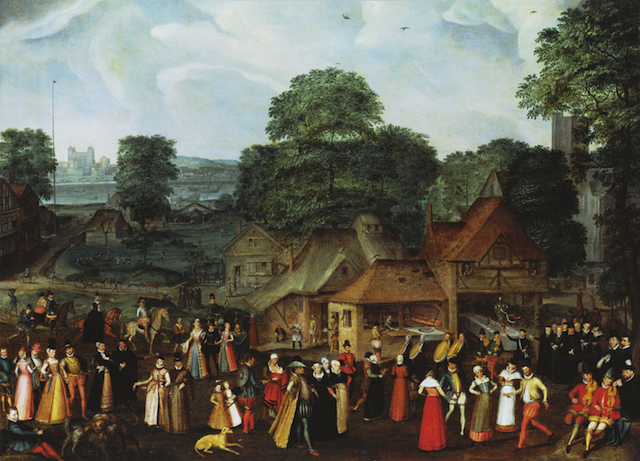At the beginning of the 17th century an anonymous Anglo-Netherlandish artist produced an elaborate procession portrait of the septuagenarian Virgin Queen, tactfully portrayed as though several decades younger, when she had succeeded to the throne in her mid-twenties. Elizabeth I is held aloft under an embroidered canopy and surrounded by Knights of the Garter, courtiers, members of the royal household, and aristocrats. Some of her 50-strong personal bodyguards, the Gentleman Pensioners, also appear; the ladies of the court follow, and privileged citizens observe the retinue from the windows of a palace in the background.
Half fantasy, half reality, the parade reflects the kind of royal procession that was a feature of the Elizabethan court, confirming both wealth and power as the Queen and her entourage journeyed through her kingdom.
Portraiture glorified the splendours of dress in rigidly codified fashion, but faces could be highly individualised
This detailed painting, a vividly theatrical tableau, sets the scene for this glimpse into an era that many historians define as the beginning, perhaps surprisingly, of modern England. Over the century London more than doubled in size, with a population of 200,000 by 1600. At the same time, there was an exponential growth of – guess what! – lawyers, as many proportionately as in the 1970s. Battles were won, notably of course the defeat of the Spanish Armada, an empire was initiated, trade advanced, mercantile fortunes were in the ascendant, the Bible appeared in English and Protestantism reigned, and the first playhouses emerged as well as a dazzling efflorescence of poetry. All are suggested by the array of portraits, many of them substantial, on view.
Indeed here is a dramatic portrait of John Donne, all swirling blacks, intensely melancholy and illuminating his long-fingered left hand and his unconventional open necked shirt. It is a surprisingly sensual painting “taken in shadows” as the poet himself said. We sense the emotional turmoil of the infatuated lover.
Then as now the rich were getting richer – 55 hereditary peers at the top of the pile, followed by knights, gentry, esquires, gentlemen, all running Parliament and the justice system, and of course the court itself, and owning two thirds of the country. But the middling classes were rising, too, while the status of the poor was dismal and getting worse. We have to infer their circumstances from documents and literature, as there is hardly any surviving material culture to show their stories, although Joris Hoefnagel’s 1560s painting of a Fête at Bermondsey (pictured below), with the Tower of London just visible, shows cooks and maids, watermen, a porter, carpenters and a man driving a cart. There are ubiquitous dogs, and of course Bermondsey seems more farmland than city. So this visual tale is perforce a story of the successful, even if for some who incurred the royal wrath, heads would roll.
 The National Portrait Gallery’s exhibition does just what its title says. It's an artful examination through marvellously detailed portraits of the grand and the up-and-coming middle classes, accompanied by exquisite portrait miniatures, clothing from ornately decorated gloves to a child’s bootee, a jewelled pomander, a rapier, a wheel-lock pistol damascened with silver and gold and completed with an engraved antler, a finely worked set of drawing instruments in brass, steel and wood, Renaissance rings of gold and gemstones, an ivory comb and a glittering small purse in the shape of a frog.
The National Portrait Gallery’s exhibition does just what its title says. It's an artful examination through marvellously detailed portraits of the grand and the up-and-coming middle classes, accompanied by exquisite portrait miniatures, clothing from ornately decorated gloves to a child’s bootee, a jewelled pomander, a rapier, a wheel-lock pistol damascened with silver and gold and completed with an engraved antler, a finely worked set of drawing instruments in brass, steel and wood, Renaissance rings of gold and gemstones, an ivory comb and a glittering small purse in the shape of a frog.
The ideal of feminine beauty from the Queen on down meant very high foreheads, thin, exaggeratedly arched eyebrows, whitened faces; men were almost invariably bearded in a variety of styles. All had unbelievable wasp waists, set off for the women by very wide skirts. The portraits contain a wealth of symbolic information and heraldic devices, elaborations which were easily read by contemporaries: the portrait of Sir Walter Raleigh is festooned with depictions of pearls, symbolising both the Virgin Queen and the poet-explorer’s devotion to his sovereign.
A rare Raleigh manuscript, from Hatfield House, its writing perfectly legible (a poem to Cynthia, the moon goddess) is also on view and seems to be part of a cycle he wrote when he disastrously fell from favour on the occasion of his secret marriage to one of the Queen’s ladies-in-waiting. Court passions ran high, and none were allowed to rival Her Majesty.
Here are characters galore; the standard of portraiture glorified the splendours of dress in rather rigidly codified fashion, with clear clues as to the status of the wearer, but faces could be highly individualised. Nicholas Hilliard’s alluring miniature shows the “cheerefull countenance” of Sir Francis Drake who, on his long voyages, mostly as a privateer, brought back much wealth. A full-scale portrait by Anonymous of Bess of Hardwick, widowed four times and a woman of immense wealth, shows us an assured and determined redhead.
The strength of this choice exhibition is to show through art, much of it rare survivors, the intertwining of politics, society and culture. It is a captivating crash course in Elizabethan history, its shadows and its glories.
- Elizabeth I and Her People at National Portrait Gallery until 5 January 2014










![SEX MONEY RACE RELIGION [2016] by Gilbert and George. Installation shot of Gilbert & George 21ST CENTURY PICTURES Hayward Gallery](/sites/default/files/styles/thumbnail_125_x_125_/public/mastimages/Gilbert%20%26%20George_%2021ST%20CENTURY%20PICTURES.%20SEX%20MONEY%20RACE%20RELIGION%20%5B2016%5D.%20Photo_%20Mark%20Blower.%20Courtesy%20of%20the%20Gilbert%20%26%20George%20and%20the%20Hayward%20Gallery._0.jpg?itok=3oW-Y84i)




Add comment